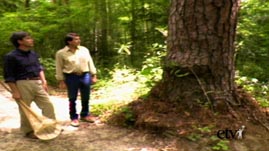Teachers' Domain - Digital Media for the Classroom and Professional Development
User: Preview

Source: NatureScene: “The Congaree Swamp”
In this video segment from NatureScene, take a tour of the Congaree Swamp National Park to learn about where the high-ground and floodplain environments meet. The boundary between dry and semi-saturated ground supports a diversity of plants, including loblolly pines and beech trees on higher ground, as well as understory plants such as doghobble and cinnamon fern. Decomposers like mushrooms, which are also understory plants, help to break down and cycle nutrients back into the soil. Plant habitat and adaptation here are predominantly influenced by soil type and saturation.
The Congaree National Park is located on a floodplain between the Upper and Middle Coastal Plain provinces in South Carolina. A floodplain is a flat, elongated piece of land found along many rivers that has been formed by erosion and sedimentation that occurs when the river floods its banks. Approximately 10 times a year, the Congaree River floods, providing essential nutrients for stimulating plant and wildlife growth in the swamp. The ancient trees at the swamp are enormous, towering above their adjacent Coastal Plain counterparts, in part, because of the nutrient rich soil of the Congaree floodplain.
Soil type and saturation in an area along the floodplain largely depends on the composition of the mineral substrate, which includes organic sediment, fine silt, and clay. Other factors include the soil’s proximity to the Congaree River, along with the degree of its permeability, and the velocity of the water during transport and deposition. An elevation change of even a few inches can result in variation in the soil’s characteristics. The subsequent growth and adaptation of various plants in the soil at the Congaree also results from this elevation change.
Two signature trees at the Congaree Swamp, both adapted to continuously flooded environments, are the bald cypress and water tupelo. These trees have well developed bases that provide added structural support to their shallow root systems. The modified roots or “knees” of the bald cypress extend from the root systems to above the standard water level. They are thought to help anchor the tree, and to act as aerial roots that assist with respiration.
Above the regular waterline, the swamp floods a wider area periodically throughout the growing season. This area consists of moist, grassy islands and ridges where trees like loblolly pine, beech, sweetgum, and holly predominate. These species grow well in the more stable terrain, which tends to drain quickly when floodwaters recede because of coarser soils and quickly deposited sediments. The beech tree, for example, requires well-drained, acidic, organic, and fertile soil.
Other plants that do well on the swamp’s higher ground include cinnamon ferns and doghobble. Cinnamon ferns prefer the open, yet water-logged areas along the edges of the swamp, generally growing in acidic soil, which is determined by the amount of lime that is present. Doghobble, an evergreen shrub, does well in occasionally wet or moist, well-drained soil. Doghobble, like mushrooms, can grow in any number of soil types including sand, loam, or clay.
Although they are usually found in damp areas, mushrooms grow well in woods, meadows, and fields, as well as in tree bark. Mushrooms are a type of fungi, and serve as decomposers in an ecosystem. Decomposers help perpetuate the cycle of nutrients by breaking down dead organic matter into the soil so that it can be recycled by living plants. In this way, mushrooms contribute to the already rich and fertile soil of the swamp, helping to propagate its diverse and abundant plant species.
To learn more about the Congaree Swamp, check out Diversity of Hardwoods at Congaree Swamp, Root Systems of Trees at the Congaree Swamp , Reptiles of the Congaree Swamp, and Primitive Insects of the Congaree Swamp.
For examples of other kinds of wetlands, see An Everglades Visit, The Value of Wetlands, and Hurricane Katrina: Wetland Destruction.
To learn more about recyclers check out Decomposers.
 Loading Standards
Loading Standards